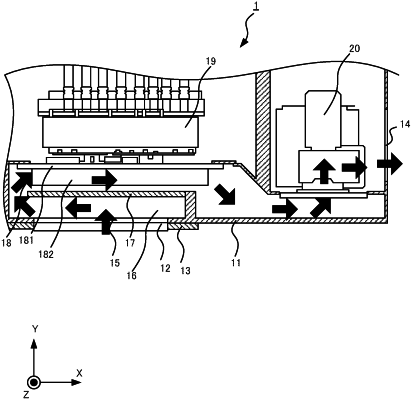| CPC H05K 7/20863 (2013.01) [H05K 7/202 (2013.01); H05K 7/20145 (2013.01); H05K 7/20181 (2013.01)] | 12 Claims |

|
1. A vehicle control device comprising:
a housing to be mounted on a vehicle, the housing having (i) a suction port through which outdoor air is taken in along a first direction being one of a width direction of the vehicle or a direction of movement of the vehicle and (ii) a discharge port from which the air taken in through the suction port is discharged;
a filter to be disposed at the suction port;
a flow passage through which the air taken in through the suction port is to pass until the air is discharged from the discharge port;
a blower disposed in the flow passage;
a blocking member that is a one-piece plate-shaped member, the blocking member being disposed, in the flow passage, at a position at which the blocking member faces a whole of an opening face of the suction port and a distance between the blocking member and the suction port is in a predetermined range;
an electronic component accommodated within the housing and disposed exterior to the flow passage; and
a radiator connected to the electronic component, to emit, from a portion of the radiator exposed to the flow passage, heat generated by the electronic component,
wherein
an end portion of the blocking member close to the discharge port is fixed to an inner wall of the flow passage, and
the air taken in through the suction port flows toward the blocking member, thereafter flows along the blocking member in a second direction away from the discharge port, flows between another end portion of the blocking member and the inner wall of the flow passage, turns in a third direction opposite to the second direction away from the discharge port, passes through the radiator, after having passed through the radiator is deflected and enters through the blower in the first direction in which the air flows in through the suction port and is discharged from the discharge port in the third direction.
|